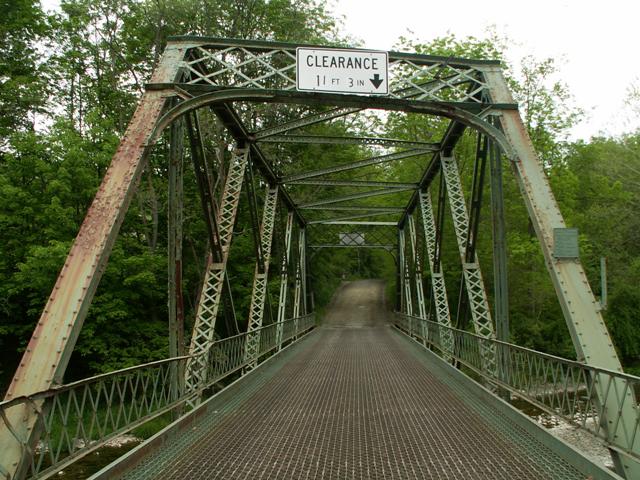We Recommend:
Bach Steel - Experts at historic truss bridge restoration.
BridgeHunter.com Phase 1 is released to the public! - Visit Now
Mosherville Bridge
Farm View Road Bridge, County Bridge Number 38

Primary Photographer(s): Nathan Holth and Rick McOmber
Bridge Documented: May 26, 2007
Rural: Bradford County, Pennsylvania: United States
1907 By Builder/Contractor: Owego Bridge Company of Owego, New York
1964
108.0 Feet (32.9 Meters)
112.0 Feet (34.1 Meters)
12.5 Feet (3.81 Meters)
1 Main Span(s)
87233076300380

View Information About HSR Ratings
Bridge Documentation
This bridge's future is at risk!
Bridge Status: Slated for demolition and replacement!View Archived National Bridge Inventory Report - Has Additional Details and Evaluation
This bridge is one of a few remaining bridges built by the Owego Bridge Company that all display the uncommon double-Warren truss configuration. All should be considered rare, historic, and worthy of preservation because outside of Bradford County, these would all be considered rare truss bridges. They are also significant for displaying the characteristics of a regionally prolific bridge company, the Owego Bridge Company, which had an apparent affinity for the truss configuration.
Information and Findings From Pennsylvania's Historic Bridge InventoryDiscussion of Bridge The skewed, one span, 112'-long, double intersection Warren thru truss bridge is supported on concrete abutments placed in 1964. The upper chords and end posts are built up box sections, and the diagonals differ in detailing depending if they are tension or compression diagonals. The floorbeams are rolled, and they are framed into gusset plates below the lower chords. The bridge appears to be complete, and it is an example of an uncommon truss design. Adding a second set of diagonals increased the capacity of the Warren design. The bridge is historically and technologically significant based on the rareness of the double intersection Warren truss design and its completeness. The bridge is attributed to the Owego Bridge Co. because of its similarity with 08 7209 0350 0013. Discussion of Surrounding Area The single lane bridge carries a township road over a stream in an area of active agriculture and scattered 20th century residences. There is a modern house beyond the NE quadrant. Bridge Considered Historic By Survey: Yes Information From Skelly and Loy Demolition Mitigation WebsiteCounty Bridge Number 38 or the Mosherville Bridge is a double intersection Warren thru truss bridge. It is a single span, 112' long bridge supported on concrete abutments. Fabrication of the bridge is attributed to the Owego Bridge Company in 1907 and the concrete abutments were placed in 1964. The upper chords and end posts are built up box sections. The tension diagonals are angles with battens and the compression diagonals are angles with lacing. The rolled floorbeams are framed into gusset plates below the lower chords. This bridge has been determined eligible for listing in the National Register of Historic Places. |
![]()
Photo Galleries and Videos: Mosherville Bridge
Bridge Photo-Documentation
A collection of overview and detail photos. This photo gallery contains a combination of Original Size photos and Mobile Optimized photos in a touch-friendly popup viewer.Alternatively, Browse Without Using Viewer
![]()
Maps and Links: Mosherville Bridge
Coordinates (Latitude, Longitude):
Search For Additional Bridge Listings:
Bridgehunter.com: View listed bridges within 0.5 miles (0.8 kilometers) of this bridge.
Bridgehunter.com: View listed bridges within 10 miles (16 kilometers) of this bridge.
Additional Maps:
Google Streetview (If Available)
GeoHack (Additional Links and Coordinates)
Apple Maps (Via DuckDuckGo Search)
Apple Maps (Apple devices only)
Android: Open Location In Your Map or GPS App
Flickr Gallery (Find Nearby Photos)
Wikimedia Commons (Find Nearby Photos)
Directions Via Sygic For Android
Directions Via Sygic For iOS and Android Dolphin Browser
USGS National Map (United States Only)
Historical USGS Topo Maps (United States Only)
Historic Aerials (United States Only)
CalTopo Maps (United States Only)

